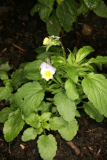Additional notes (click to expand)
Medicinal
Viola tricolor L. Violaceae. Heartsease. Distribution: Europe. Gerard (1633) writes that it is good for fevers especially for children and infants whose convulsions and fits of the falling sickness it is thought to cure' These are presumably the febrile convulsions of childhood which stop when the fever subsides, whatever one does. He also says it is good for chest conditions, itching all over, and ulcers and 'to cure the pains of the French disease [syphilis]'. It is approved for topical use in mild seborrhoeic dermatitis because of traditional use, in Europe, but a trial of a cream containing V. tricolor was no more effective than the base cream without ingredients. A child with glucose-6-phosphate dehydrogenase deficiency developed haemolysis ('favism') following oral administration. It also contains salicylates so should be used with caution (European Medicines Agency, Assessment report on Viola tricolor, November 2010).
Oakeley, Dr. Henry F. (2013). Wellcome Library notes.
link
Toxicity
A child with glucose-6-phosphate dehydrogenase deficiency developed haemolysis ('favism') following oral administration. It also contains salicylates so should be used with caution (European Medicines Agency, Assessment report on Viola tricolor, November 2010).
Oakeley, Dr. Henry F. (2013). Wellcome Library notes.
link
Geographical distribution
- Asia-Temperate, Siberia
- Asia-Temperate, Western Asia, Iran
- Asia-Temperate, Western Asia, Turkey
- Europe, Eastern Europe
- Europe, Middle Europe
- Europe, Northern Europe
- Europe, Northern Europe, Great Britain
- Europe, Southeastern Europe
- Europe, Southwestern Europe
Viola tricolor L.
Family: VIOLACEAEGenus: Viola
Species: tricolor L.
Common names: European wild pansy; heart's-ease
Distribution summary: Europe, Temperate Asia
Conservation status (IUCN Red List): Least Concern
Habit: Annual
Hardiness: H4 - Hardy; average winter
Habitat: Roadsides, wasteland & cultivated land
Garden status: Currently grown
Garden location: Arid zones (Q), Europe & Mediterranean (E)
Flowering months: April, May, June, July, August, September
Reason for growing: Medicinal, other use, toxic
.JPG)
.JPG)
.JPG)
.JPG)
.JPG)
